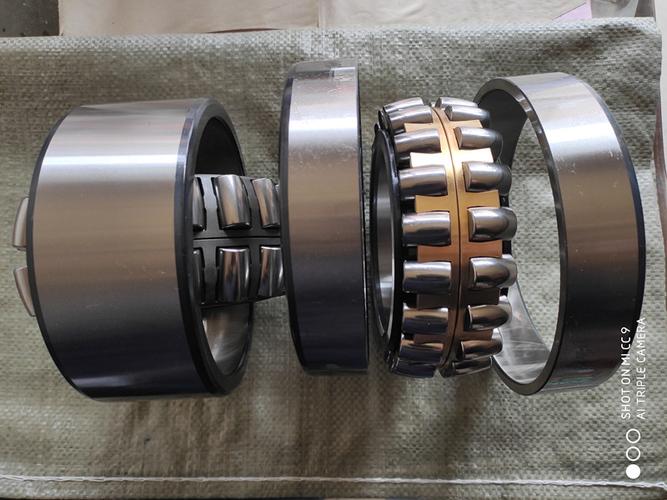The bearings of mechanical equipment are vulnerable parts, and whether their running status is good directly affects the performance of the entire equipment. In cement machinery and equipment, there are many cases of equipment failure caused by early failure of rolling bearings. Therefore, finding out the root cause of the fault, taking remedial measures, and eliminating the fault is one of the keys to improving the system operation rate.
1 Fault analysis of rolling bearings
1.1 Vibration analysis of rolling bearing
A typical way for rolling bearings to fail is simple fatigue spalling of their rolling contacts. {TodayHot} This kind of peeling, the peeling surface area is about 2mm2, and the depth is 0.2mm~0.3mm, which can be judged by detecting the vibration of the monitor. Spalling can occur on the inner race surface, outer race or rolling elements. Among them, the inner race is often broken due to high contact stress.
Among the various diagnostic techniques used for rolling bearings, the vibration monitor monitoring method is still the most important one. Generally speaking, the time-domain analysis method is relatively simple, suitable for occasions with little noise interference, and is a good method for simple diagnosis; among the frequency-domain diagnosis methods, the resonance demodulation method is the most mature and reliable, and is suitable for precise diagnosis of bearing faults; time- The frequency analysis method is similar to the resonance demodulation method, and it can correctly characterize the time and frequency characteristics of the fault signal, which is more advantageous.
1.2 Analysis of the damage form of rolling bearings and remedies
(1) Overload. Severe surface spalling and wear, indicating the failure of rolling bearings due to early fatigue caused by overload (in addition, too tight fit will also cause a certain degree of fatigue). Overloading can also cause severe bearing ball raceway wear, extensive spalling and sometimes overheating. The remedy is to reduce the load on the bearing or increase the load carrying capacity of the bearing.
(2) Overheating. A change in color in the raceways of the rollers, the balls, or the cage indicates that the bearing has overheated. The increase of temperature will reduce the effect of lubricant, so that the oil desert is not easy to form or disappear completely. If the temperature is too high, the material of the raceway and the steel ball will be annealed, and the hardness will decrease. This is mainly caused by unfavorable heat dissipation or insufficient cooling under heavy load and high speed. The solution is to fully dissipate heat and add additional cooling.
(3) Low load vibration erosion. Elliptical wear marks appeared on the axial position of each steel ball, which indicated failure caused by excessive external vibration or low load chattering when the bearing was not in operation and no lubricating oil film was produced. The remedy is to isolate the bearing from vibration or add anti-wear additives to the grease of the bearing, etc.
(4) Installation problems. Mainly pay attention to the following aspects:
First, pay attention to the installation force. Spaced indentations in the raceway indicate that the load has exceeded the elastic limit of the material. This is caused by static overload or severe impact (such as hitting the bearing with a hammer during installation, etc.). The correct installation method is to apply force only to the ring to be pressed (do not push the outer ring when installing the inner ring on the shaft).
Second, pay attention to the installation direction of angular contact bearings. Angular contact bearings have an elliptical contact area and bear axial thrust in one direction only. When the bearing is assembled in the opposite direction, because the steel ball is on the edge of the raceway, a groove-shaped wear zone will be generated on the loaded surface. Therefore, attention should be paid to the correct installation direction during installation.
Third, pay attention to alignment. The wear marks of the steel balls are skewed and not parallel to the direction of the raceway, indicating that the bearing is not centered during installation. If the deflection is >16000, it will easily cause the temperature of the bearing to rise and cause serious wear. The reason may be that the shaft is bent, the shaft or the box has burrs, the pressing surface of the lock nut is not perpendicular to the thread axis, etc. Therefore, care should be taken to check the radial runout during installation.
Fourth, attention should be paid to the correct coordination. Circumferential wear or discoloration on the assembly contact surfaces of the inner and outer rings of the bearing is caused by the loose fit between the bearing and its matching parts. The oxide produced by abrasion is a pure brown abrasive, which will cause a series of problems such as further wear of the bearing, heat generation, noise and radial runout, so attention should be paid to the correct fit during assembly.
Another example is that there is a serious spherical wear track at the bottom of the raceway, which indicates that the bearing clearance becomes smaller due to tight fit, and the bearing quickly fails due to wear and fatigue due to the increase in torque and the rise in bearing temperature. At this time, as long as the radial clearance is properly restored and the interference is reduced, this problem can be solved.
(5) Normal fatigue failure. Irregular material spalling occurs on any running surface (such as a raceway or a steel ball), and gradually expands to cause an increase in amplitude, which is a normal fatigue failure. If the life of ordinary bearings cannot meet the requirements of use, it is only possible to re-select higher-grade bearings or increase the specifications of the first-class bearings to increase the load-carrying capacity of the bearings.
(6) Improper lubrication. All rolling bearings require uninterrupted lubrication with high-quality lubricants to maintain their designed performance. The bearing relies on an oil film formed on the rolling elements and races to prevent direct metal-to-metal contact. If lubricated well, friction can be reduced so that it does not wear out.
When the bearing is running, the viscosity of the grease or lubricating oil is the key to ensure its normal lubrication; at the same time, it is also crucial to keep the lubricating grease clean and free of solid or liquid impurities. The viscosity of the oil is too low to fully lubricate, so that the seat ring wears out quickly. At the beginning, the metal of the seat ring and the metal surface of the rolling body directly contact and rub against each other, making the surface very smooth? Then dry friction occurs? The surface of the seat ring is crushed by the particles crushed on the surface of the rolling body. The surface can be observed at first as a dull, tarnished finish, eventually with pitting and flaking from fatigue. The remedy is to re-select and replace the lubricating oil or grease according to the needs of the bearing.
When pollutant particles contaminate lubricating oil or grease, even if these pollutant particles are smaller than the average thickness of the oil film, the hard particles will still cause wear and even penetrate the oil film, resulting in local stress on the bearing surface, thereby significantly shortening the bearing life . Even if the concentration of water in lubricating oil or grease is as small as 0.01%, it is enough to shorten half of the original life of the bearing. If water is soluble in oil or grease, the service life of the bearing will decrease as the concentration of water increases. The remedy is to replace the unclean oil or grease; better filters should be installed at ordinary times, sealing should be added, and cleaning operations should be paid attention to during storage and installation.
(7) Corrosion. Red or brown stains on the raceways, steel balls, cages, and ring surfaces of the inner and outer rings indicate corrosion failure of the bearing due to exposure to corrosive liquids or gases. It causes increased vibration, increased wear, increased radial clearance, reduced preload and, in extreme cases, fatigue failure. The remedy is to drain the fluid from the bearing or to increase the overall and external seal of the bearing.
2 Causes and treatment methods of fan bearing failures
According to incomplete statistics, the failure rate of abnormal vibration of fans in cement plants is as high as 58.6%. The vibration will cause the fan to run unbalanced. Among them, the improper adjustment of the bearing adapter sleeve will cause abnormal temperature rise and vibration of the bearing.
For example, a cement plant replaced the fan blades during equipment maintenance. The two sides of the vane are fixedly matched with the bearings of the bearing seat by an adapter sleeve. After re-testing, the high temperature of the free end bearing and the fault of high vibration value occurred.
Disassemble the upper cover of the bearing seat and turn the fan manually at a slow speed. It is found that the bearing rollers at a certain position of the rotating shaft also roll in the non-load area. From this, it can be determined that the fluctuation of the bearing running clearance is high and the installation clearance may be insufficient. According to the measurement, the internal clearance of the bearing is only 0.04mm, and the eccentricity of the rotating shaft reaches 0.18mm.
Due to the large span of the left and right bearings, it is difficult to avoid deflection of the rotating shaft or errors in the installation angle of the bearings. Therefore, large fans use spherical roller bearings that can automatically adjust the center. However, when the internal clearance of the bearing is insufficient, the internal rolling parts of the bearing are limited by the movement space, and its automatic centering function is affected, and the vibration value will increase instead. The internal clearance of the bearing decreases with the increase of the fit tightness, and a lubricating oil film cannot be formed. When the bearing running clearance is reduced to zero due to temperature rise, if the heat generated by the bearing operation is still greater than the dissipated heat, the bearing temperature will drop Climb quickly. At this time, if the machine is not stopped immediately, the bearing will eventually burn out. The tight fit between the inner ring of the bearing and the shaft is the cause of the abnormally high temperature of the bearing in this case.
When processing, remove the adapter sleeve, readjust the fit tightness between the shaft and the inner ring, and take 0.10mm for the gap after replacing the bearing. After reinstallation, restart the fan, and the vibration value of the bearing and the operating temperature return to normal.
Too small internal clearance of the bearing or poor design and manufacturing precision of the parts are the main reasons for the high operating temperature of the bearing. The housing bearing. However, it is also prone to problems due to negligence in the installation procedure, especially the adjustment of the proper clearance. The internal clearance of the bearing is too small, and the operating temperature rises rapidly; the taper hole of the inner ring of the bearing and the adapter sleeve are too loosely matched, and the bearing is prone to failure and burning in a short period of time due to loosening of the mating surface.
3 Conclusion
To sum up, the failure of bearings should be paid attention to in design, maintenance, lubrication management, operation and use. In this way, the maintenance cost of mechanical equipment can be reduced, and the operating rate and service life of mechanical equipment can be extended.
Post time: Feb-10-2023

